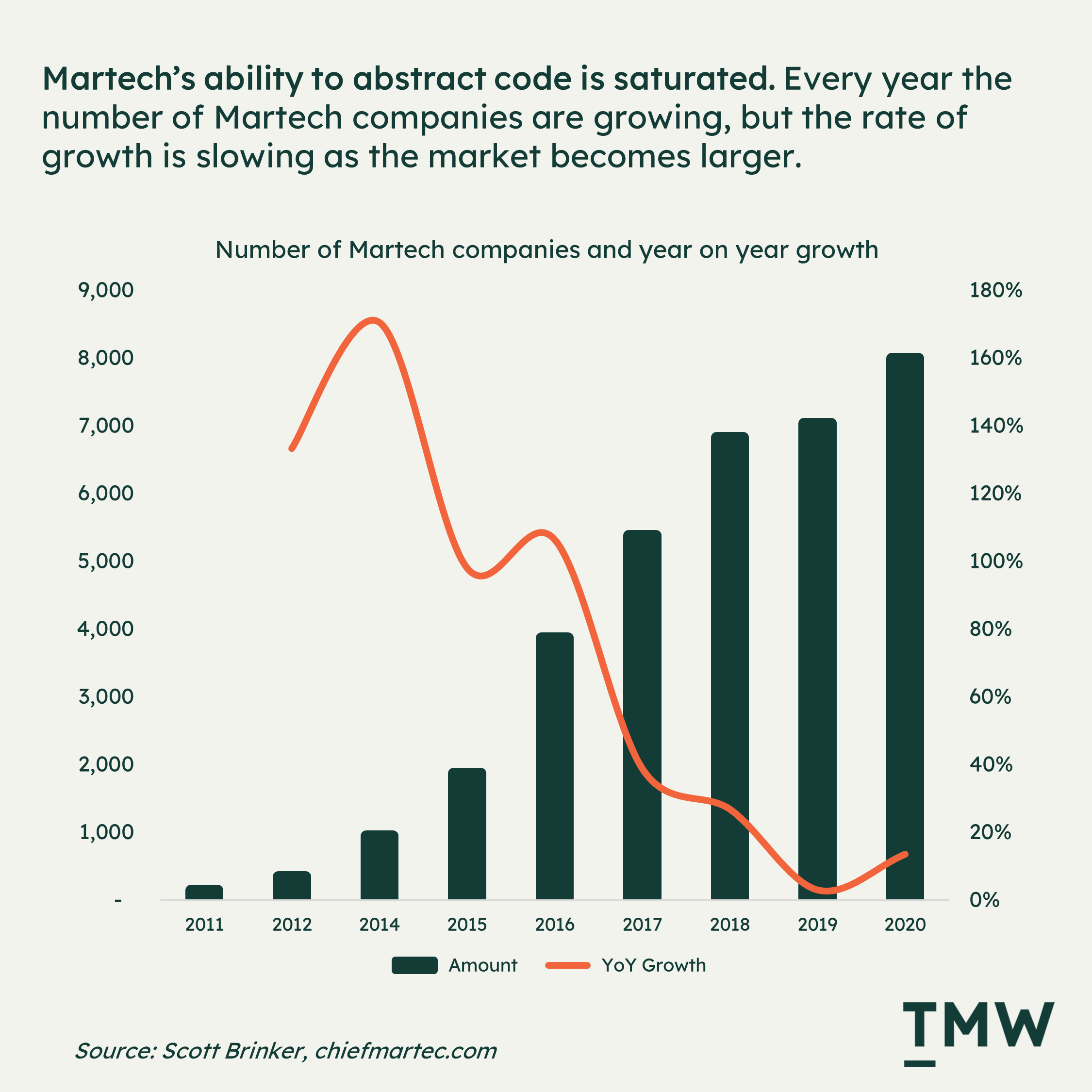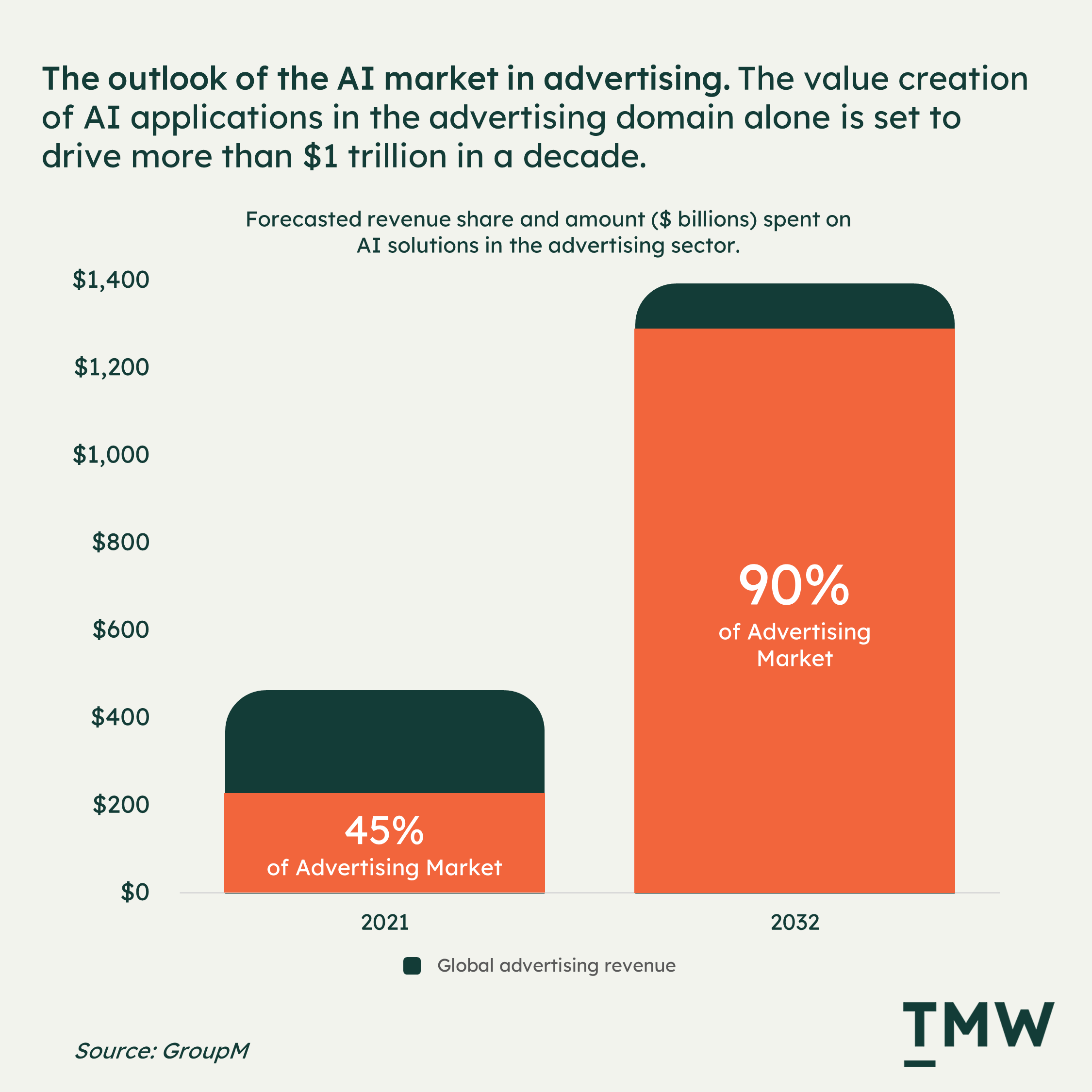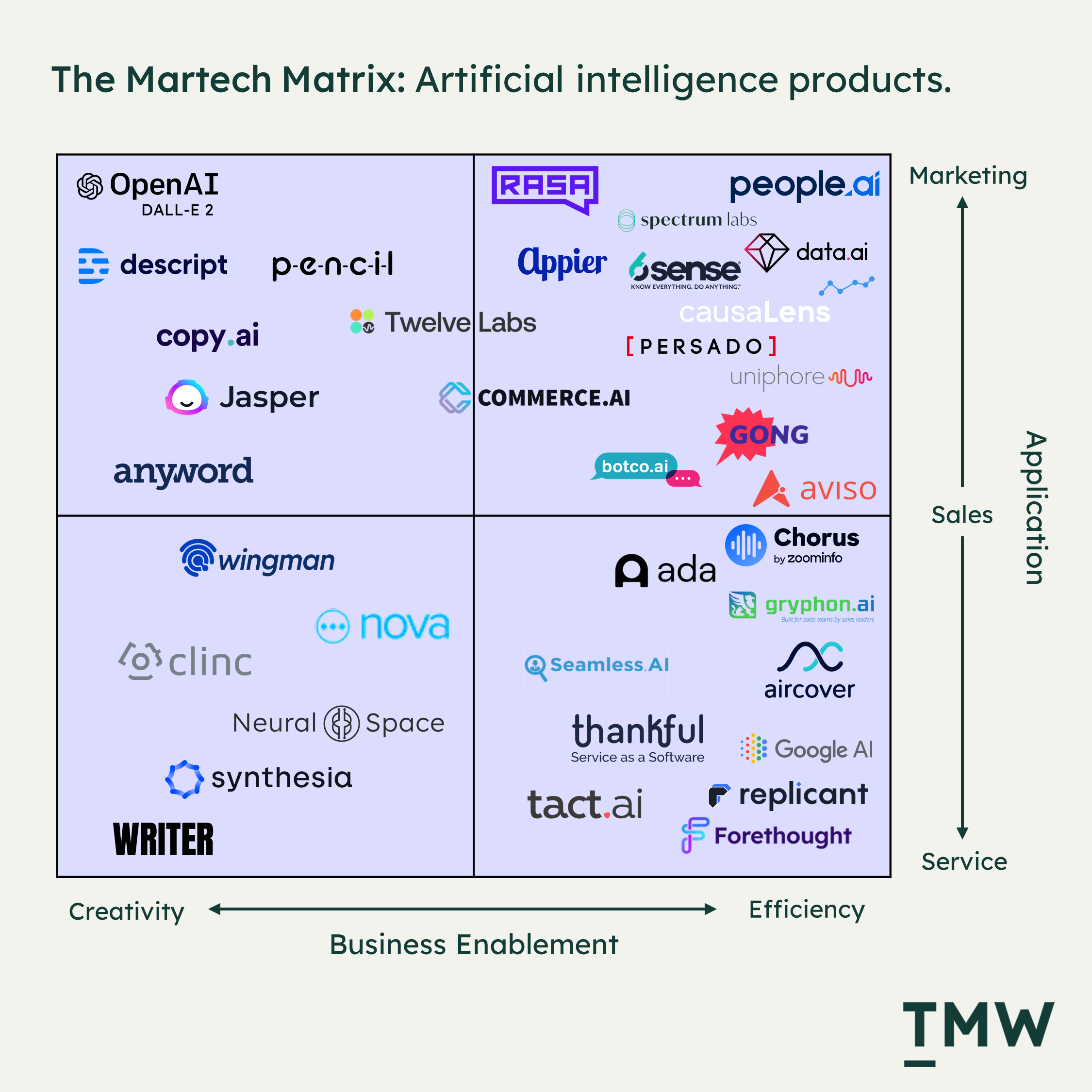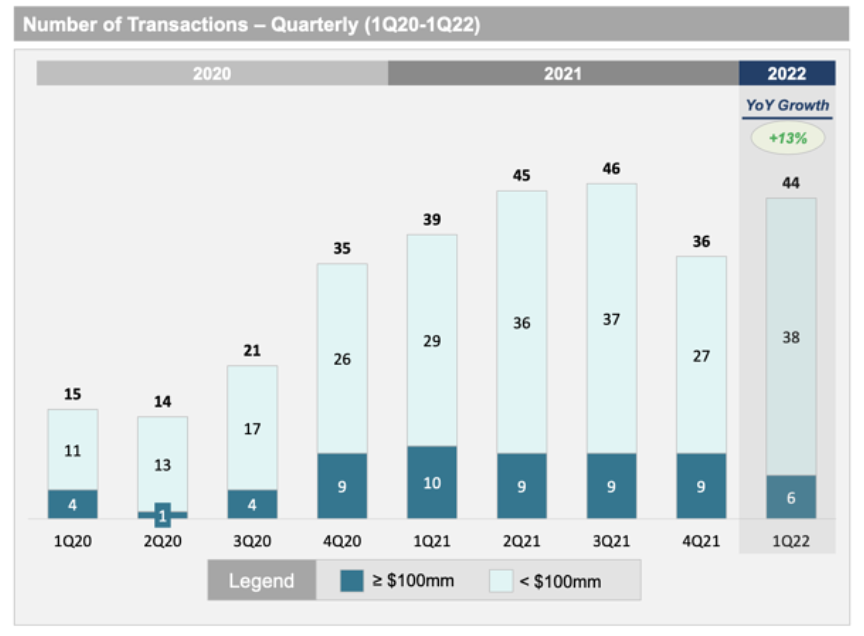TMW #078 | The great abstraction, Martech M&As and big tech regulation in the EU
Welcome to The Martech Weekly, where every week I review some of the most interesting ideas, research, and latest news. I look to where the industry is going and what you should be paying attention to.
👋 Get TMW every Sunday
TMW is the fastest and easiest way to stay ahead of the Martech industry. Sign up to get the full version delivered every Sunday for this and every TMW, along with an invite to the TMW community. Learn more here.
Here’s the week in Martech:
● The great abstraction. AI and the next wave of Martech companies
● Martech M&As. The market is maturing (and healing)
● EU big tech regulation. Different ways to think about limiting power
● Everything else: Martech Alliance diversifies, Elon and Twitter, a deep dive into Ethereum, data cleanrooms, crypto crime, retail media, email marketing in China, Lego in the metaverse, and something called “Zuck Bucks.”
✍ Commentary
The great abstraction. From time to time, I dabble in researching artificial intelligence and its impact on marketing technology. In this post, I’ll be dabbling again but with a specific goal: I want to blow your mind with what’s possible in our industry today. Artificially intelligent marketing technology companies are quietly and consistently building the next layer of marketing, sales, and customer service tools.
The abstraction of code into the useful tools we use every day to power marketing (like the email system that I used to send you this email) was the catalyst for the entire Martech category. Analytics software, creative software, marketing software, website builders, and the rise of the low/no code solutions brought us to today – the ability to launch apps, illustrate images, analyse marketing performance and build campaigns with little to no technical experience. The global Martech industry is now worth more than $344 billion, thanks to the ability to turn code into products.
All hail the GUI.
But the next wave of Martech is a step-change in how we think about abstracting technology for everyday use in marketing, sales or customer service. Instead of turning code into marketing utilities, we’re turning data and logic into viable tools to replace human skills.
How? When the first marketing automation platform was built it gave marketers the ability to significantly augment the way marketers prepare and send people to the sales department, or when the first no-code website builder came to it market gave the small business owner the ability to start selling products directly online without a development team. These two examples I just explained to you are part of the past twenty years of technological abstraction in business.
Sales and marketing don’t normally spend their days writing code, they don’t do data engineering and they are definitely not building APIs. But Martech gave us the power of scalable technology, data and most importantly the ability to create for our customers online.
We’re at a stage now that so much has been abstracted for marketing and sales that we’ve hit our peak. The main stuff like the ability to build a website, create an email and run ads online is already here and everything else is now an edge case, or a verticalized solution for a specific industry. It’s crowded and noisy and while the number of Martech companies keeps rising, growth has stalled.

This begs the question - is there really any other kinds of complexity and scale that can be abstracted away for a large market of users who will find it useful enough to pay for? I would argue that yes, there is. But it requires a shift of thinking away from SaaS and apps to the kinds of skills and abilities that marketing, sales, customer service, art direction, and analytics bring to work every day. Up until this point we’ve been abstracting software. The next generation of apps will be abstracting and scaling people and their valuable skills.
If you look across the artificial intelligence market, the amount of funding that’s going into the sector for companies that overlap with marketing, customer experience or sales is mind-blowing. AI in advertising alone is estimated to be driving more than $500 billion in revenue during 2022 according to GroupM. There’s a reason for this – the most costly aspect of any marketing department outside of spending on advertising are the people. It’s the senior UX designer wanting a $200k salary for their in-demand skills or the CMO who is making half a million dollars a year.
Taking the most cynical of arguments for AI replacement is that people are an expensive, non-scalable resource that you have to pay for when they are not working. If you want a truly valuable business, you’ll want to be creating technology that automates and abstracts the roles of people within your company as much as possible. Any company worth their executive team must be looking at AI progressing quickly along Moore’s Law of innovation and be thinking about how they can create a technological moat by building more scalable and efficient teams with defensible IP and industry-specific algorithmic training.

Enter stage right: The great abstraction. In the world of Martech there’s an explosion of AI technologies that are slowly, incrementally, and efficiently taking slices away from various roles that used to be staffed with flesh and blood humans. Here’s a sampling. The technology that triggered this commentary was the recent release of DALL-E 2 from OpenAI. It’s a technology that has progressed GAN (Generative Adversarial Networks) to a point that the app can create illustrations that are indistinguishable from professional digital designers. All you need to do is explain an idea like a man with half a robot face in plain text for the app to generate artwork for you within seconds and produce a variety of options and styles.
This was one of the first moments where I immediately wanted to hire this AI to create cover art for my essays here at TMW. Why would I pay an illustrator $200 for a piece of digital art when I have a dozen options based on what I want, some of which are more interesting and unique than what’s out there in the marketplace?
The interesting thing about DALL-E 2 is that there have been many other similar apps that have attempted to get studio-quality generated images with varying degrees of success. GPT-3, also from OpenAI is working towards the goals of a fluid generative image system that can be rolled out at scale, but none compare to the quality and creativity of DALL-E 2. This solves both the problem of expensive designers to create custom illustrations and marketers resorting to stock imagery - custom images on demand and at scale.

There are other applications of creativity that AI companies are working on. Copy AI and Pencil are both text-based artificial intelligent companies that you can start using today to generate everything from homepage copy to Facebook ads. According to CopyAI, over half a million marketers are using their technology, including enterprise companies like Nestle and Microsoft. Others like Botco.ai and RASA automate content distribution for things like a newsletter and chatbots. In all these examples there are integrations to hard data on user engagement, creating a loop of learning both to meet business outcomes and train the model for self-reinforced optimization.
Prediction analytics is another interesting domain in which AI is taking chunks of work away from the analyst. There are AI models that can do things like eye tracking to predict human attention. One company, Neurons Predict has a 95% accuracy rate when predicting user eye actions when presented with various stimuli. Other applications are predictive models like data.ai, 6sense and people.ai that run probabilistic models on things like the likelihood of a customer to purchase after their first time or to determine the next best interaction and channel to engage a customer.
Abstractions around building products in the no-code space are also taking an important turn. Products like OpenAI’s Davinci model are now advanced enough to build simple games and applications based on the instructions you give them. Even Salesforces is eying the technology to bring voice-directed AI coding capabilities to their customers. No code is just wrapping a GUI around a development environment, but telling a computer what app you want, what it should look like, and how it should handle data, using just your voice is a completely new domain. The breakthrough of natural language processing in AI is also one of the major achievements driven mostly by OpenAI’s public application of GPT-3 which is still very early in the development cycle for an AI.
In the sales arena, there is even more interesting augmentation of existing roles. Apps like Gong, which recently won G2’s most ranked app of the year, and has raised more than $600 million in venture funding use machine learning to optimize prospect data to drive sales interactions and create more efficiency. So much so that the company claims to have increased revenue per sale by 27%. The app is surrounded by many other examples like Chorus, Aviso and Ada that are all doing something similar in the sales automation space.
If so much of the lead qualification process is managed by automated systems, then there’s no real need to hire a massive workforce of people to hustle on the phone and over email. McKinsey suggests that two-thirds of B2B buyers now opt for remote or digital self-service, which means that business customers are adopting online purchasing that enables greater data collection over intent and preference. The equation here is not hard: More customers interacting with brands online equals more data to train AI models for lead management which results in a smaller workforce to deal with more customers.

As you can see, the sheer diversity of AI products is leading the industry to greater abstraction. It’s likely that people working in creative roles won’t know how to use Adobe Illustrator in the future, but rather will have to know the right questions to ask DALL-E 2 to produce the kinds of creativity they want. It takes a lifetime of honing a craft like digital illustration, but for an AI program, it takes only weeks or days.
The challenge with AI programs in creativity is that they can scale creativity across all formats which is inherently useful. But is it inspirational? Is it moving? Does it connect with people? Knowing that a human created something will always have some value assigned to it by association.
Creative automation will have an outsized influence in some parts of marketing and not in others. Advertising can be automated to a point and giving a copywriter a hundred options to expand their thinking can only be a good thing, whereas art direction could be less influenced by AI. People value status and prestige more than most of us care to admit and advertising awards tap into this in a powerful way. Nonetheless, who knows? Maybe an AI will win a Cannes Lion one day? It’s not outside the realm of the possible to the dismay of creative directors everywhere.
Sales and customer service departments will be further abstracted and automated. Sales experts will need less training on qualifying and closing leads and play a more supporting role throughout a customer’s journey. These skills are being abstracted at scale which opens a whole new world of opportunity. Like the advent of the smartphone or even the television, there’s a trickle, then a flood of technologies that redefine how things are done, and more importantly who does them. Payroll-heavy departments are already the first to be replaced by AI-driven automation, creativity, and communication.
In the great abstraction, the “Mar” will play a supporting role and the ”tech” will abstract away the complexities and with them, most of our responsibilities. Pair this with the artificial customer (TMW #074). It’s not hard to see that the future of the internet won’t look anything like web3 or the metaverse (both concepts that are fundamentally people-centric), but rather it will be an environment of abstraction where the complexities of buying, selling, and serving are blissfully managed by our machines. Links: DALL-E 2, GROUPM, FORBES, SALESFORCE, AI AND ART, NDA, CB INSIGHTS, MTA REPORT, VENTURE BEAT, GAN OVERVIEW.
📈Chart Of The Week
How are the Martech markets going? Overall mergers and acquisitions made in the Martech sector are up 13% last quarter with the majority of the growth coming from the $100 million and up category. Note that it’s not as high as the previous peak around the mid-way of 2021 and there’s a slowdown of smaller acquisitions. A lot of the activity in Martech is moving towards late-stage VC and private equity firm as the category continues to mature. In other words, it’s a great time to have built a Martech company ten years ago. Link

📰 Latest Developments
EU’s attempt to regulate big tech. You’ve probably heard about the Digital Markets Act (DMA) which was recently announced by the EU government. The act is an interesting, and somewhat unclear initiative to limit the power of big tech companies (companies with over $80 billion in market cap) by forcing interoperability between platforms, and limiting the kinds of features and products a company can launch inside the EU if there’s substantial cause for it to be anti-competitive. If there’s anything close to this that goes into enforcement in the EU it will mean that advertisers will likely see higher prices to run ads but also space for startups to play in areas previously limited like social media and search. Links: DIGIDAY, FT, EU PRESS, THE TIMES.
Martech Alliance diversifies. The UK based education company in the marketing technology category has rebranded to LXA – The Learning Experience Alliance and launched two new services in what the company is calling “salestech” and “nextech.” Martech is already a massive umbrella of technologies, so it makes all kinds of sense to broaden the approach to training in sales which is a discipline that is constantly being disrupted by technology and offering guidance around emerging tech such as Web3 and the metaverse. It’s likely only the beginning of what LXA is trying to do as it’s not hard to imagine Martech unbundling further and communities forming around customer experience, logistics, and ML tech streams. Link
Elon and Twitter. Elon Musk, the #1 troll on Twitter with more than 80 million followers has acquired 9.1% of Twitter and has been appointed to the board making him the company’s largest shareholder and turning Twitter into a meme stock overnight. The interesting thing about this is Musk’s overt product ideation in public which, at his reach and scale, makes for the kind of soft power and influence we’ve probably not seen play out with a public company before. So far Elon’s advocating for making the algorithm public domain, an edit button and making users pay to use Twitter to limit bot activity. With this kind of uncertainty on Twitter and other social platforms, investing time into building social media audiences seems unwise. Links: PLATFORMER, GALLOWAY, ELON
📚 Reading
A deep dive into Ethereum. This is an interview with Vitalik Buterin on his view of the now popular and first blockchain to offer software development on-chain. A mostly technical discussion that explores the problems of decentralization and scale and the ecosystem Ethereum has built. The more I think about it, the more it makes sense that Ethereum is becoming the Shopify of crypto. Link
Data cleanrooms or bust. A strong argument for the technology as the next layer of advertising targeting and attribution. While everyone else is scrambling around to find the next “third party cookie” Google and Amazon are building cleanrooms as a way to replace much of what makes up third-party tracking and attribution. Cleanrooms are kind of like the Switzerland of audience data: The value exchange can happen between parties without revealing PII. Links: NDA, NYTs.
The modern marketing data stack. The landscape of marketing data is changing rapidly and how marketers are using data to enable sales and service is progressing to real-time as the norm. Some of this has to do with more data warehouse adoption, cloud technologies and the advent of CDPs. Link
🔢 Data & Insights
Crypto crime. Chainalysis is one of the more respectable research firms tracking the crypto industry. They are saying that crypto empowered crime rose to an all-time high in 2021, with criminals raking in more than $14 billion which is about double that of 2020. Brands, please tread carefully. Link
Martech in the metaverse. An analysis of how Martech intersects with interoperable, 3D worlds and a categorisation of the various technologies from experience to infrastructure. One reason to be bullish about whatever the metaverse will become is the sheer amount of involvement from category-leading brands. Link
BCG on retail media. This report underscores my hypothesis about why so many retail brands are launching their own DSPs. 3rd party cookie deprecation + regulation + Apple privacy controls = demand for new, scalable advertising channels. This report suggests that the market for retail media will grow by 25% year on year to a $100 billion market. There’s also another reason why it’s so attractive: It’s a profitable business model for eCommerce that’s differentiated by 1st party purchase data. Link
💡 Ideas
Meta-analysis and experimentation. A guide to working out what to learn from experiments as a “hierarchy of evidence.” Link
Chinese email marketing. Future does a deep dive into the effectiveness of email marketing in the region and what Chinese companies do differently. The central question of the research is this – does email need to be a one-way channel? Link
Lego X Epic Games. This partnership is a metaverse-esque experiment which bets for the idea that the next generation will not see much of a difference between physical and digital play. Link
✨ Weird and Wonderful
Zuck Bucks. After two failed attempts at launching a digital currency, Meta is now pursuing what’s known by employees as “Zuck Bucks” which tells you pretty much everything you need to know about the company’s crypto ambitions. Link
Designing buildings with Microsoft Word.Link
NFT’s next target? Dungeons and Dragons. All of the nerd space on the internet is slowly being swallowed up by the blockchain. Link
Stay Curious,
Make sense of marketing technology.
Sign up now to get TMW delivered to your inbox every Sunday evening plus an invite to the slack community.
Want to share something interesting or be featured in The Martech Weekly? Drop me a line at juan@themartechweekly.com.
